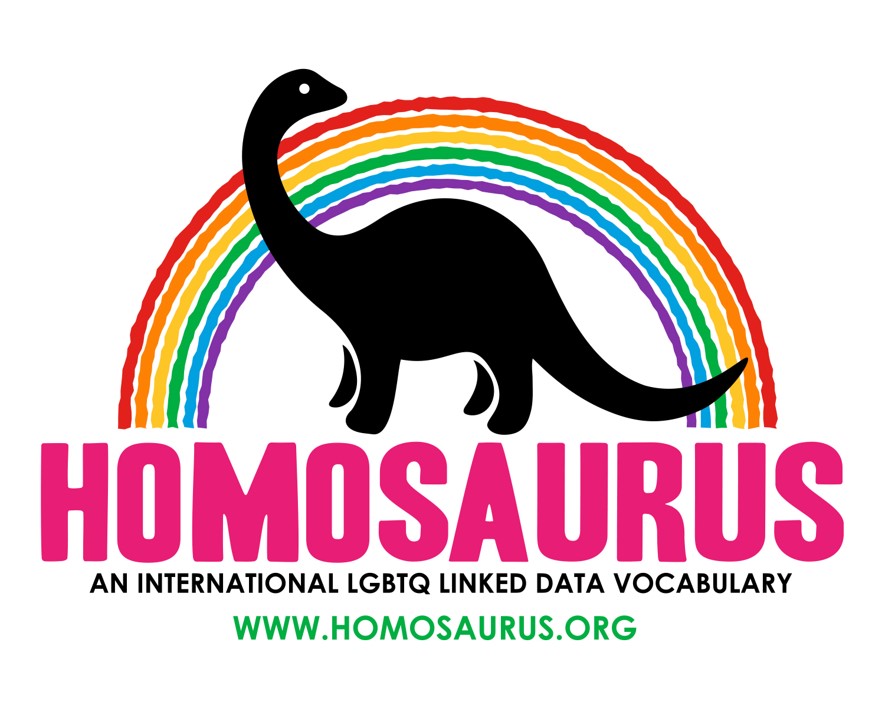
The Homosaurus is an international linked data vocabulary of LGBTQ terms that is intended to function as a companion to broad subject term vocabularies, such as the Library of Congress Subject Headings. Libraries, archives, museums, and other institutions are encouraged to use the Homosaurus to support LGBTQ research by enhancing the discoverability of their LGBTQ resources.
Deze tekst is een geschreven bewerking van de presentatie die Jack van der Wel en Walter “Cat” Walker gaven op de ALMS-conferentie in 2019 in Berlijn: The Abridged Homosaurus: A Supplement to Existing Retrieval Systems.
ALMS staat voor Archives, Libraries, Museums and Special Collections.
History
The Homosaurus was originally created in 1997 by IHLIA LGBT Heritage as a Dutch and English gay and lesbian thesaurus that was used as a standalone vocabulary to describe their collections. Over time, terms relating to bisexuality, trans, gender, and intersex concepts were added, but not methodically. This original version of the vocabulary (which we consider version 0) had a too flat structure and, due to the lack of many connections, terms were too isolated from one another and therefore easily missed. But, it became apparent that a vocabulary developed by an LGBTQ archives to be used to describe LGBTQ resources could be a powerful tool.
In 2013, Jack van der Wel, with the help of Ellen Greenblatt, transformed the original Homosaurus into a more inclusive and hierarchical thesaurus (version 1). Hundreds of terms were added and each term was put in relation to others in a hierarchical structure. The vocabulary continued to exist as an offline document that was circulated as a Word document or PDF. The results of this major editing project were presented at numerous LGBTQ ALMS Conferences and the vocabulary began to be used by other LGBTQ archives, libraries, and documentation centres throughout the world.
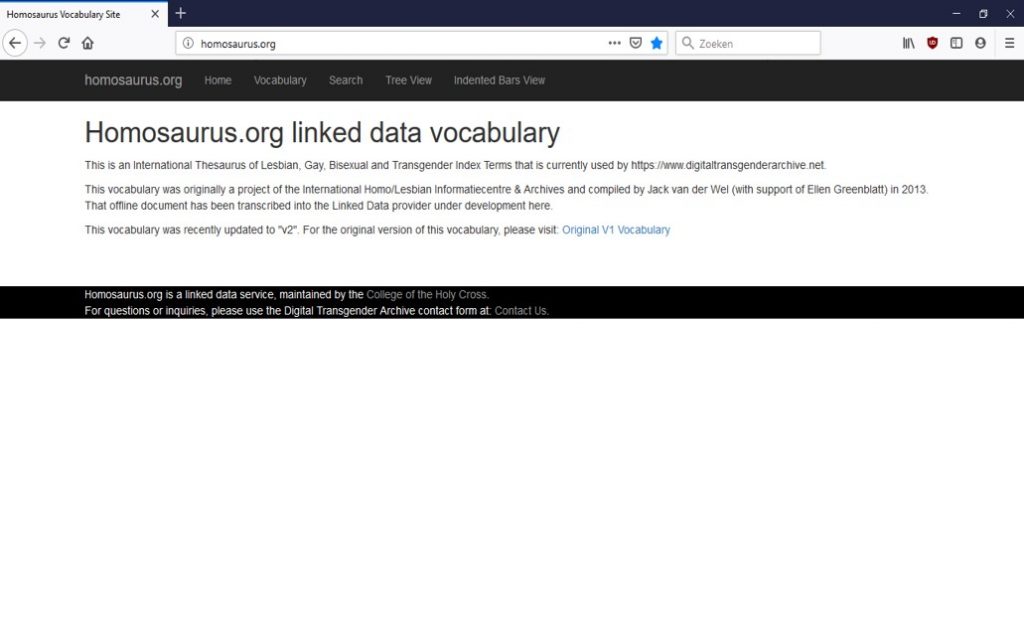

In 2015, the Digital Transgender Archive (DTA) became one of the handful of LGBTQ archives using version 1 of the Homosaurus to describe resources in their collections. When it became apparent to the DTA’s Director, K.J. Rawson, how useful the vocabulary was and how many institutions could benefit from using it, he proposed to Jack van der Wel that they transform version 1 into an online linked data vocabulary. This would dramatically increase the accessibility of the vocabulary and would allow cultural institutions from around the world to share a common vocabulary.
In 2016, Rawson and van der Wel established an Editorial Board to oversee a second major revision of the Homosaurus. The board ultimately decided to transform the Homosaurus from a broader, standalone vocabulary (which included non-LGBTQ terms, such as “advertising” and “literature”) to a narrower, LGBTQ-specific vocabulary that was intended to supplement existing thesauri (primarily the Library of Congress Subject Headings). This was a major conceptual shift and this revision resulted in version 2.
In May, 2019, version 2 of the Homosaurus was released at www.homosaurus.org as a linked data vocabulary. The Editorial Board is now focused on publicizing the project and making ongoing edits to the vocabulary.
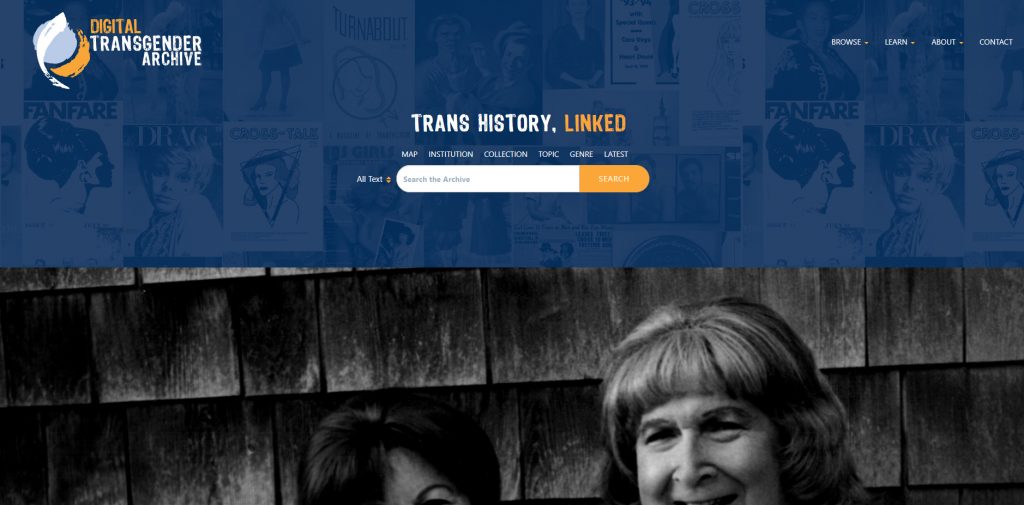
Editorial Board
The first meeting of the Editorial Board was on August 16, 2016, with 6 of the 7 original members present online via Skype. Jack from the Netherlands, and Orla Egan from Ireland, joined Amber Billey, Marika Cifor, K.J. Rawson, and myself from the United States. Dee Michel, another American, was unable to attend.
We decided that we should create an abridged version that would be only LGBTQI terms, as there are many non-LGBTQI terms in the original Homosaurus. This would have more possible terms for use in indexing LGBTQI resources than general thesauri such as Library of Congress Subject Headings (LCSH), and could be used as a supplemental thesaurus in libraries, archives, and digital collections. We spent some time discussing how the Homosaurus is currently used (mostly by IHLIA and the Digital Transgender Archive), and how people identify themselves, which can be different from how they were identified at birth and/or how they present themselves in appearance, as well as how open they are about their sexual orientation and gender identity.
We divided up a spreadsheet containing all the Homosaurus terms amongst the 7 board members, and began figuring out which terms were LGBTQI-specific and should be kept, which should be discarded, and which ones needed discussion first.
We met every 1-2 months to review our revisions, and to discuss what types of terms we should try to keep as LGBTQI-related. For example, we tried to keep terms for sexual activities, but not for body parts, and to keep feminism terms. We decided to keep LGBTQI-related LCSH terms in the abridged Homosaurus, since they often link to non-LCSH terms in the Homosaurus’ hierarchies (and would be expected to be included).
In Summer 2017, we started reviewing groups of terms that were related and which we were uncertain about. These groups included religion and ethnicity, drugs, sexually transmitted diseases, sexual practices, identity terms, and relationships and family.
We decided to cut broad religion and ethnicity terms, but to keep specific LGBTQ-related terms, such as “two-spirit people”
We also added many transgender-related terms from the Digital Transgender Archive’s list of global terms.

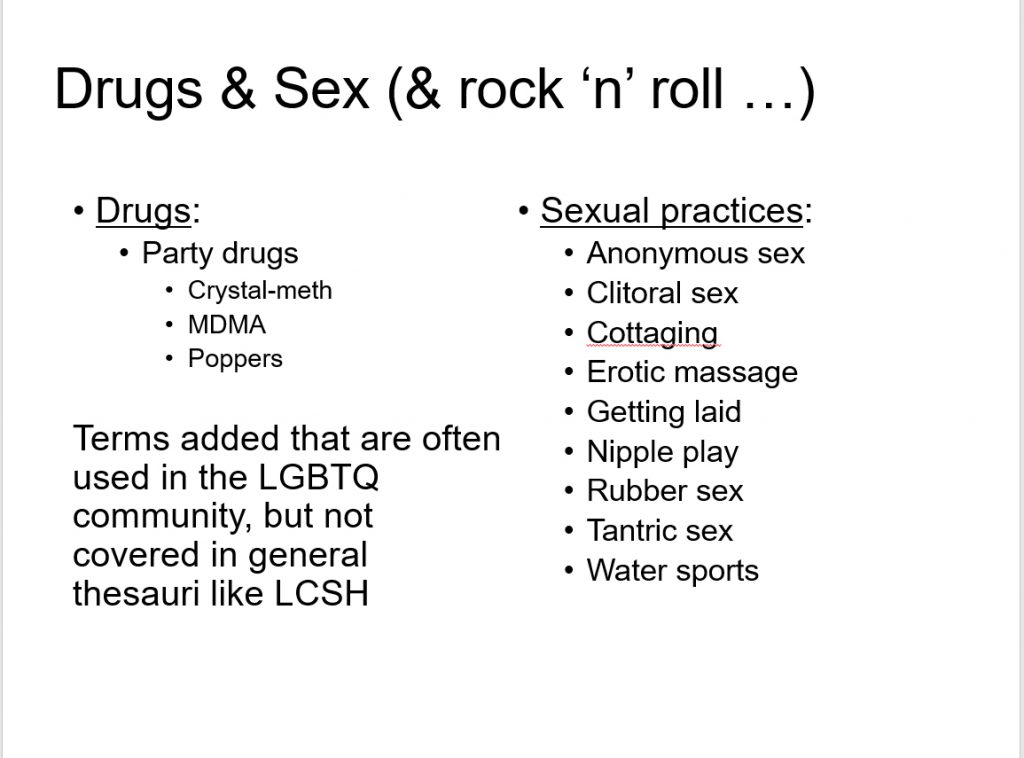
For drugs, we decided to add terms for those that are often used in the LGBTQ community, but not covered in LCSH (such as “poppers”). We tried to follow a similar approach to STD terms and sexual practices, with slang terms occasionally included.
We discussed whether “gay” should be used as an umbrella term (as in LCSH) or only used to mean “gay male.” We decided to use “LGBTQ” as our umbrella term (instead of “gay” or “queer”).
Whenever we wanted to have separate sexual orientation/gender orientation terms for a concept, we used “[Concept] (LGBTQ)” as the broader term (BT), with narrower terms (NTs) for “bisexual [concept]”, “gay [concept]”, “lesbian [concept]”, “queer [concept]”, and/or “transgender [concept]”.
For example, under the broader term “Families (LGBTQ)” there are narrower terms for “Bisexual families”, “Gay families”, “Lesbian families”, “Queer families”, and “Single parent families”, and “Transgender families”. Another example is “Bars (LGBTQ)”, which has narrower terms for “Bisexual bars”, “Drag bars”, “Gay bars”, “Lesbian bars”, and “Transgender bars”.
Some concepts that did not seem to need breaking out to narrower bisexual, gay, lesbian, queer, and transgender terms have “LGBTQ” in front to distinguish from non-LGBTQ aspects of the term. LGBTQ is generally used for people, when possible (such as LGBTQ prisoners instead of LGBTQ prisons.
As time went on, we finished deleting non-LGBTQ terms and started adding new LGBTQ-related terms. Earlier we often discussed term changes amongst the group first, but eventually we began making the changes and discussing them afterwards, or creating separate documents with proposed terms and then discussing those. A lot of additions and changes were made to transgender-related terms, and many of these were contributed by college students working with K.J. in the Digital Transgender Archive (DTA).
Last summer, we distinguished between “Sex (Body)” and “Sex (Act)” We also discussed where “fucking” went (between the broader term “Sex (Act)” and the narrower term “Ass fucking”).
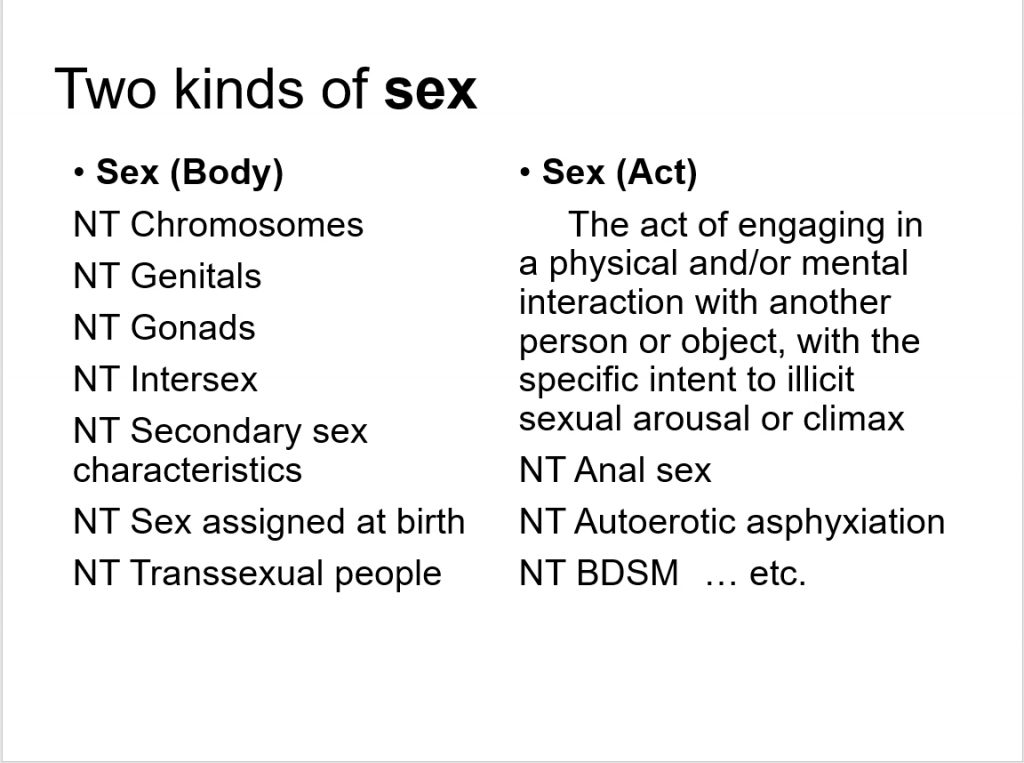
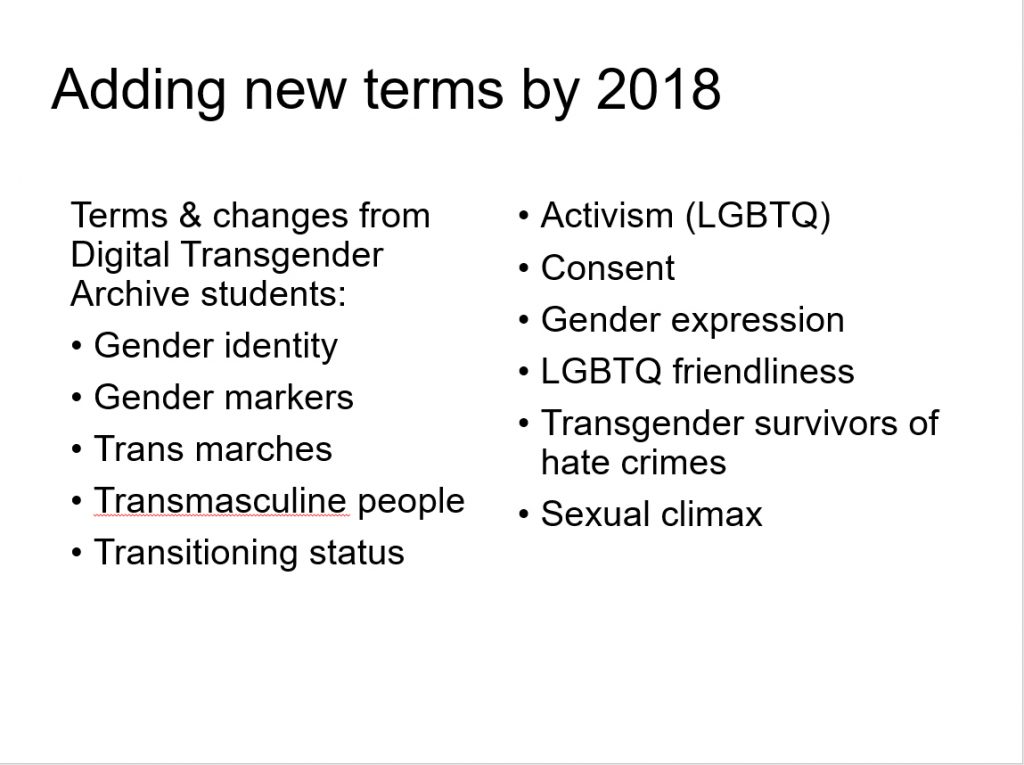
Scope notes were edit to some of the culturally-specific gender identities and more trans-related terms were added. In October 2018, the Editorial Board set a goal of finishing our revisions by the end of the calendar year, and then transforming it into an online version by early 2019.
During the next few months, we continued to revise some terms, such as Pride celebrations, prejudice and discrimination, masculinity, sexual consent, butch/femme identity, circumcision, and privilege. We also dealt with some remaining questions, such as: sexual orientation vs. sexual preference; rape and victims of rape; public bathrooms as a site of anti-transgender discrimination and phobia; acronyms; discrimination and phobias.
By January 2019, we finished reviewing several separate documents of terms, such as the “Queer Sex Ontology”, “Family Terms”, “Personal and Family Law”, and “Identity Terms”, and incorporated them into the abridged Homosaurus.
The Google Doc was exported into an Excel spreadsheet, so that it could be transferred into the linked data online form. We took a break from meeting for a while, and then resumed meeting quarterly to discuss new terms and general editing, and how we want the website to be set up. On May 1, 2019, our work became available as a linked data vocabulary online at: http://homosaurus.org.
We met on May 9 to start planning our future steps, which include publicizing and increasing the usage of the Homosaurus. There was a presentation at the 2019 LGBTQ ALMS Conference in Berlin and all six Editorial Board members are planning to start writing three articles about the Homosaurus for potential publication during the coming year. There were also presentations to LGBTQ libraries and archives from Germany, Austria and Switzerland at Queer Search meetings in November 2017 and November 2018 in Berlin.
The Homosaurus has been approved to use as a thesaurus source for subject headings in MARC records, with the code being “homoit”. We also decided to create some publicity materials, and to add new members this Fall. It will be easier to update in its database form, and plan to set up a page on the website for submissions of new terms and for suggestions of further revisions.
The Homosaurus is meant to evolve, as vocabulary usage in this area keeps changing. Many terms and identities have just recently come into general use, and we expect this pattern to continue.
We are also looking for more Editorial Board members, and hope that our group becomes more international and diverse.
In juni 2020 bereikte ons het verdrietige bericht dat Walter “Cat” Walker onverwachts was overleden. Lees een in memoriam op de website van Loyola Marymount University.


